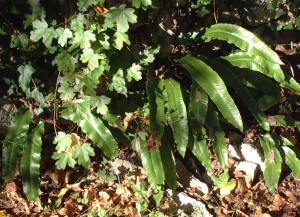Flora
The Caves of Oliero are situated in a botanical park surrounded by the natural vegetation of the valley side created by naturalist Alberto Parolini in the 1800s. At the lowest altitudes you can see typical flowers that populate the Prealpine areas in the Veneto between the plains and the Dolomites. The common primrose and cowslip (Primula vulgaris and Primula veris), violet and heartsease (Viola hirta and Viola tricolor), snowdrop (Galanthus nivalis), green hellebore (Helleborus viridis),dog’s tooth violet (Erythronum dens-canis), alpine squill (Scilla bifolia), lungwort (Pulmonaria officinalis), liverwort (Hepatica nobilis) and white nettle (Lamium album).

Some plants, like the heart-leave globe daisy (Globularia cordifolia) and thyme (Thymus serpyllus), like a drier climate, while others like dwarf periwinkle (Vinca minor) and fraxinella (Dictamnus albus) prefer a cooler climate. Moving away from the valley bottom and heading up the sides you find flowers associated with mountain environments: common oak (Quercus pubescens), South European flowering ash (Fraxinus ornus), European hop-hornbeam (Ostrya carpinifolia) and Cornelian cherry (Cornus mas). Other species that can survive in harsh conditions are quite common too, such as flax (Linum narbonense) and marsh gladiolus (Gladiolus palustris) and other climbing plants, like black bryony (Tamus communis) and old man’s beard (Clematis vitalba).
In the lateral valleys, with their cool, damp climates, you can find woodland species like small-leaved lime (Tilia cordata), sycamore (Acer pseudoplatanus), hazelnut (Corylus avellana), chestnut (Castanea cativa), blackberry bushes (Rubus fruticosus) and wild roses (Rosa canina). As regards the Caves, the rock walls above host the tufted horned rampion (Physoplexis comosa L. Schur), a campanulacea found in the Southern Alps. The cave park is populated by many other colourful flowers, tall trees planted by Parolini almost two centuries ago and ferns, like hart’s tongue (Phyllitis scolopendrium).

